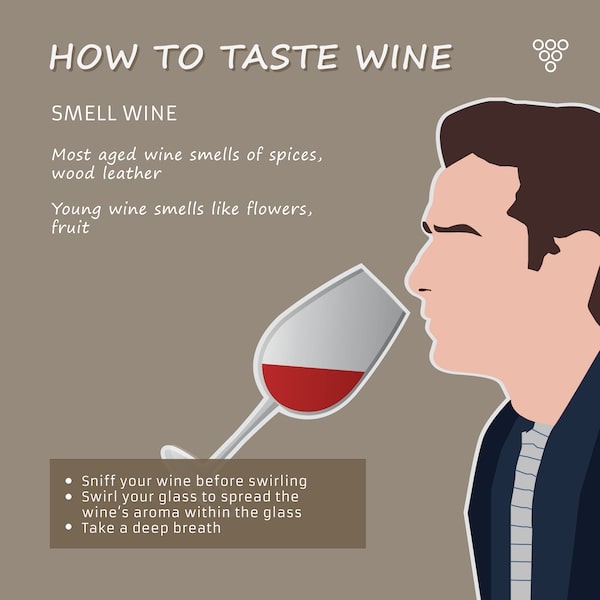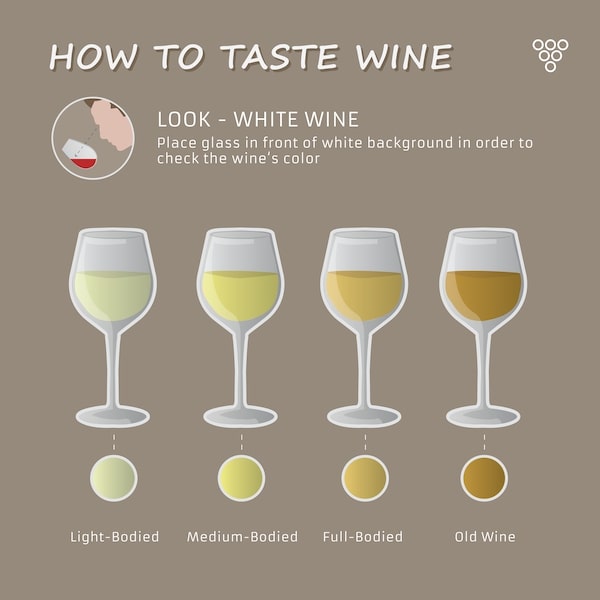Smell wine - what are the olfactory notes?
What isn't there is probably more of a question. If you can identify an odor, it usually exists. After all, humans are able to distinguish up to 1 trillion smells. Flavors in wine range from freshly cut grass to summer rain and can vary greatly from person to person. There are almost no limits to the imagination here.
How do I determine the wine aroma in the nose?
Being able to distinguish flavors precisely is a gift, but one that can be learned through targeted training. A large part of the human taste experience comes from our sense of smell, so smelling is just as important as tasting.
Smelling wine properly is not a challenge in itself. Connoisseurs usually attach importance to the angle. About 45 degrees is enough. You stick your nose into the glass and inhale gently.
Smell and taste usually differ in intensity. In many cases, however, also through aromas that can only be found in the nose. For this reason, it is all the more important to inspect the wine nasally.

Wine colors - What colors are there?
Wine is more than just white wine or red wine. Even if colors can be roughly classified, 'red' is not the same as 'red'. The color of the wine is mostly determined by the grape and the thickness of the skin. Smaller factors such as alcohol content and fermentation also contribute to the color. Wine colors are divided into 3 categories with their respective sub-categories:
Rot:
Fading into the dark, these wine colors are classified as copper, brick, garnet, ruby or purple.

White:
Graded in ascending order of color intensity, white wine is classified as either straw, yellow, gold or amber.

Rosé:
The spectrum of rosé ranges from pink to salmon to copper.
How do I classify wine colors?
A skill that is difficult to learn. However, if you have a sufficiently healthy sight, the vocabulary to describe recognized colors is usually missing.
Whether for trained or untrained eyes, the best way to color classify a wine is to hold it in front of a white, neutral background. This makes the visible structure of a wine more clearly recognizable.
Wine taste - What flavors are there?
Flavors of taste can be divided into three main categories.
Primary:
Flavors of this type are among the most intense. They depend on the grape variety and the terroir. Primary aromas are usually assigned to fruits or spices. However, there are no limits to the actual assignments.
Secondary:
These aromas arise during the production of wine, more precisely during the process Fermentation. They do not necessarily have to be weaker and do not have any aromatic restrictions.
Tertiary:
By tertiary aromas are meant all aromas that can be attributed to the aging process. These arise from the expansion in the barrel and from the aging in the bottle. In the process, the fruity and spicy molecules fall apart and combine with other molecules. In this way, an extremely interesting spectrum of aromas develops.
Tasting wine: how do I drink wine properly?

Drink. Sip the wine like hot tea and try to get it under your tongue. Holding the wine in your mouth even a second longer makes for a more pronounced taste experience. Proper tasting is an art in itself.
Wine glasses - which glass for which wine?
This was already widespread in ancient Egypt wine glass enforced through the millennia. Thus also knowing how to use it correctly. Because even with wine glasses there is a great diversity with the associated methodology.
Although glasses often serve ornamental reasons, there is an etiquette about how to exploit their maximum potential.
Round glasses are usually suitable for red wine, while goblet glasses with a horizontal base or edges are more suitable for white wine or rosé. Thin tall glasses are suitable for sparkling wine and its perlage.
You can find more about this topic in our blog articles on the topic red wine glasses.
How do I hold a glass?
According to etiquette, one touches the glass anywhere that the goblet is not. This is avoided to protect the wine from the heat of your fingers, which could spoil the taste.
Traditionally, the glass is always held by the stem, with the number of fingers proportional to the size of the glass.
Thumb and forefinger are enough for a small white wine glass, for a medium-sized glass the middle finger is added. do you have a big one red wine glass, so even the ring finger can rush to help.
Many Winemaker He even grabs the foot of a glass to make it easier to swing it.
Haven't learned enough about wine yet?
In our article "10 things you should know about wine", we explain the basics that you should know about wine.











